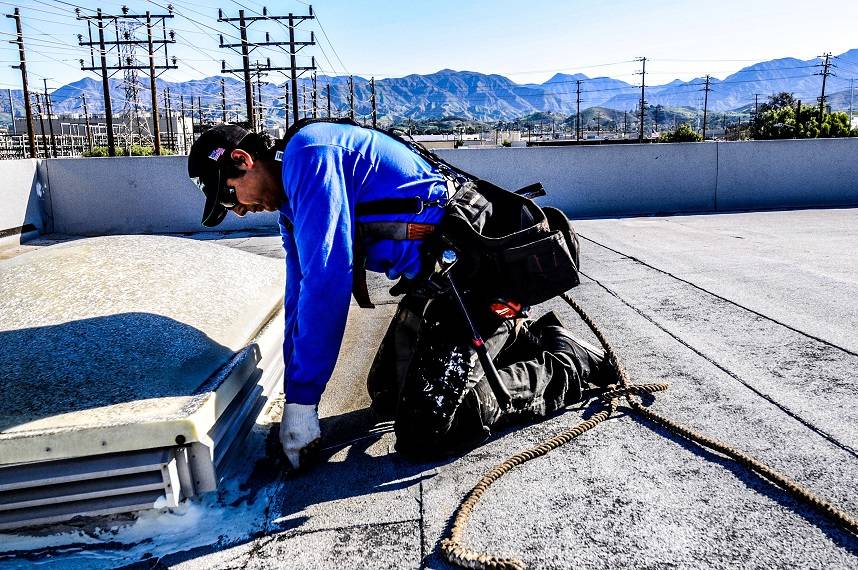Schedule Free Estimate
5 Ways The Sun Destroys Your Commercial Roof
Your commercial roof, a crucial protective shield against the elements, endures daily exposure to the sun’s powerful rays. While we often appreciate the sun for its warmth and light, it’s important to recognize that its energy can also have detrimental effects on our roofs. Over time, the sun’s relentless assault can cause significant damage to roofing materials, compromising their integrity and potentially leading to costly repairs or replacements.
In this article, we will explore five ways in which the sun can wreak havoc on your roof. Understanding these factors will not only help you comprehend the mechanisms behind roof damage but also enable you to take proactive measures to mitigate their impact. From ultraviolet radiation to thermal cycling and heat buildup, each element plays a distinct role in the gradual deterioration of your roof’s health.
By delving into these damaging effects, we aim to equip homeowners with the knowledge necessary to safeguard their roofs and prolong their lifespan. Whether you are a seasoned homeowner or a first-time buyer, understanding the risks posed by solar exposure is essential for making informed decisions about roofing materials, maintenance, and overall protection of your property.
So, let us embark on this journey to explore the five ways the sun damages your roof, unraveling the intricacies of solar impact and providing you with valuable insights to preserve the integrity of your home’s first line of defense.
1. Ultraviolet (UV) Radiation:
The sun emits UV radiation, which is one of the primary causes of damage to roofs. Over time, prolonged exposure to UV rays can lead to the degradation of roofing materials. The UV radiation breaks down the chemical bonds within the roofing materials, causing them to become brittle, fade in color, and lose their structural integrity.
2. Thermal Cycling:
The sun’s heat causes constant expansion and contraction of the roofing materials, a phenomenon known as thermal cycling. This repetitive process weakens the roof’s structure and can lead to cracks, warping, and splitting. As a result, water can penetrate through these openings, leading to leaks and water damage.
3. Heat Buildup:
The sun’s intense heat can cause excessive heat buildup in the attic space beneath the roof. This trapped heat can result in higher energy costs as it forces air conditioning systems to work harder to maintain comfortable indoor temperatures. Additionally, prolonged exposure to high temperatures can cause the roof’s underlayment to deteriorate, reducing its effectiveness as a barrier against moisture.
4. Fading and Discoloration:
The sun’s powerful UV rays can cause the color of roof shingles or other roofing materials to fade over time. This fading effect is particularly noticeable in materials that are exposed to direct sunlight for extended periods. Discoloration not only affects the appearance of the roof but can also indicate underlying damage and reduced protective capabilities.
5. Moisture Damage:
Although not a direct consequence of the sun’s rays, the sun’s heat can contribute to moisture-related roof damage. The combination of high temperatures and thermal cycling can cause roofing materials to expand and contract, creating gaps or spaces that allow water to penetrate the roof system. Once moisture infiltrates the roof, it can lead to rot, mold growth, and the deterioration of the roof’s structural components.
Conclusion
As we conclude our exploration of the five ways in which the sun damages your roof, it becomes evident that solar exposure poses significant challenges to the longevity and performance of this vital component of your home. From the relentless UV radiation that weakens materials to the constant thermal cycling and heat buildup that lead to deterioration, the sun’s influence cannot be underestimated.
However, armed with this understanding of the damaging effects, you now possess the knowledge to take proactive measures to protect your roof. Regular inspections, timely repairs, and the use of UV-resistant materials can go a long way in mitigating the detrimental impact of solar exposure. Additionally, considering reflective coatings or insulation to reduce heat buildup and ensuring proper ventilation will help maintain a healthier roof environment.
Remember, the health of your roof directly impacts the overall well-being of your home, safeguarding it from the elements and providing peace of mind. By actively addressing the challenges presented by the sun, you can extend the life of your roof, save on costly repairs, and maintain the integrity of your property.
In closing, we hope this article has shed light on the intricate relationship between solar exposure and roof damage. Armed with this knowledge, you can now take informed steps to protect and preserve your roof’s strength and functionality. By staying vigilant and implementing preventive measures, you can ensure that your roof continues to shield your home for years to come, enabling you to fully enjoy the comfort and security of your cherished abode.
Central Roofing Company Headquarters
555 W. 182nd Street
Gardena, CA 90248
310-527-6770

Get A Quote
One of our roofing estimators will gladly meet you to discuss your options and follow up with a free, no-obligation, written estimate.
At Central Roofing Company, we understand that a sturdy and reliable roof is crucial for the success and safety of your commercial property. Our team of highly skilled and trained roofing professionals is committed to delivering exceptional craftsmanship and superior service in every project we undertake.
555 W. 182nd St. Gardena, CA 90248
Ph: 310-527-6770
Our Office Locations:
Our Services
CA license #684960 – Central Roofing, 2024 ©All Rights Reserved | Terms of Use | Privacy Policy | Built by Dymic